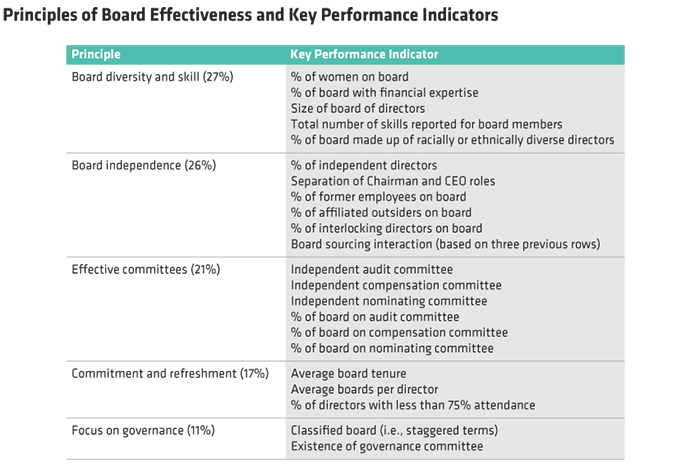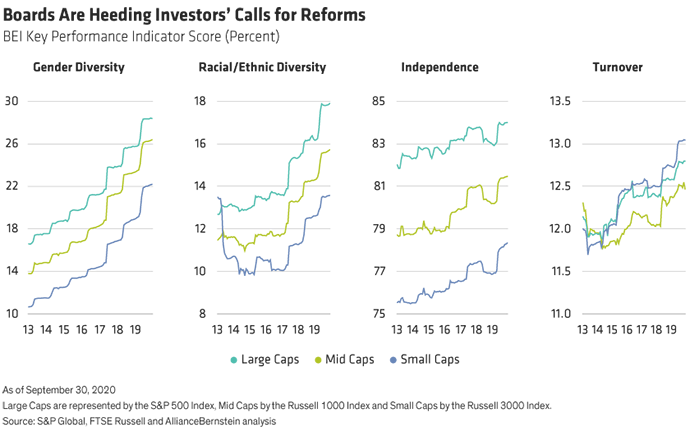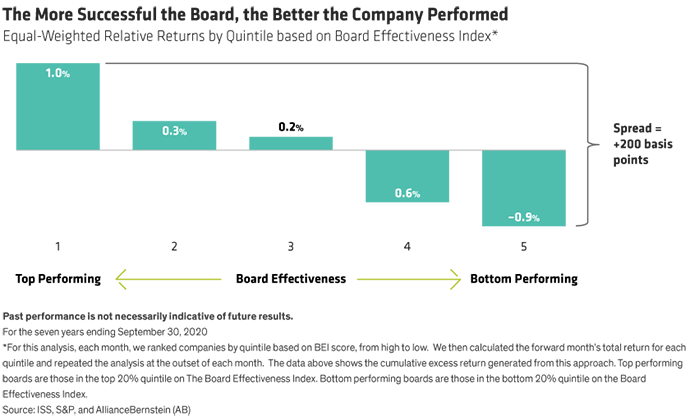Prevailing wisdom suggests that companies with good corporate governance practices perform better financially and generate stronger returns. But which attributes matter most when measuring board success? Is there a way to compare companies over time and across sectors? And above all, does board effectiveness translate to better performance?
Board meetings by their nature tend to be exclusive, closed-door affairs. That makes it impossible for investors to observe them directly. But it is possible to measure key performance indicators, such as a board’s composition, policies, and actions. By aggregating these indicators, we can create a holistic picture—as we’ve done with our Board Effectiveness Index (BEI). This tool allows us to objectively evaluate the effectiveness of company boards in our investment universe, while serving as a guidepost to engaging them on governance-related issues.
Appraising Performance in the Boardroom
Think of boards as astute arbiters charged with aligning the incentives of shareholders, management, and other stakeholders. While this may seem like a purely subjective role, our analysis helps identify those that make the grade. We started with 23 distinct attributes valued by investors based on the proxy voting policies of asset managers, asset owners, proxy advisory firms, and subject matter experts. We then weighted these attributes by importance and aggregated them into key principles.
Diversity and skill ranked as the top trait—followed by independence—accounting for 27% and 26% of the Board Effectiveness Index, respectively. Why? Board diversity helps provide directors with a range of perspectives while encouraging a more meritocratic business climate firmwide. And boards consisting of mainly independent directors can help mitigate conflicts, ensuring that executives’ actions align with the interests of shareholders and other key stakeholders.
Beyond these two principles, successful boards also tend to have effective committees (21%), commitment and refreshment of corporate directors (17%), and a focus on governance (11%) (Display). It’s not hard to see why these characteristics are so highly prized. Keeping key subcommittees (audit, nominating, and compensation, in particular) independent and all committees adequately sized increases the likelihood that relevant issues are monitored and managed. Routine refreshment and safeguards that prevent directors from sitting on too many boards (“overboarding”) ensures that boards are continuously exposed to new ideas and directors have enough bandwidth to carry out their roles. Finally, boards with a governance focus tend to keep their two primary duties—a duty of care and duty of loyalty—front and center. This includes avoiding self-dealing and conflicts of interest.

Signs of Progress
Calls by investors for improved corporate governance practices have not fallen on deaf ears. Key performance indicators have been improving for small-, mid-, and large-cap companies in the US. Not surprisingly, large-cap companies are leading the way when it comes to gender diversity, racial/ethnic diversity, and board independence. A notable exception is board turnover, where smaller-cap companies have taken the lead.

Effectiveness Goes Hand in Hand with Future Returns
Does board effectiveness translate to better performance? Our internal analysis showed a tight correlation between the effectiveness of a company’s board and future stock returns. To illustrate, we divided the universe of stocks in the S&P 500 into quintiles, based on each company’s BEI score. We then looked at the stock performance of each cohort over a seven-year period. The results were remarkable: the top quintile outperformed by the widest margin while the bottom quintile underperformed substantially. The “spread” between the top and bottom quintiles was 2%—a significant gap for US large-cap equities (Display).

Measurement Matters
With tools like the BEI, environmental, social, and governance issues can be measured with the same rigor that’s used to assess return and risk. By analyzing companies using objective data—rather than subjective assessments—investors gain a more nuanced understanding. That’s because comparing companies to their peers based on sector, industry, size, or other characteristics provides much-needed context. With a proven link between good governance and shareholder returns, measurement tools like the BEI will hopefully prompt more shareholders to scrutinize the effectiveness of the boards of the companies in which they invest.
- Valerie Grant
- Senior Portfolio Manager—Responsible Investing
- Dan Terry
- Quantitative Research Analyst
1For this analysis, each month we ranked companies by quintile based on BEI score, from high to low. We then calculated the forward month’s total return for each quintile and repeated the analysis at the outset of each month. The data above shows the cumulative excess return generated from this approach. Source: ISS, AB analysis

